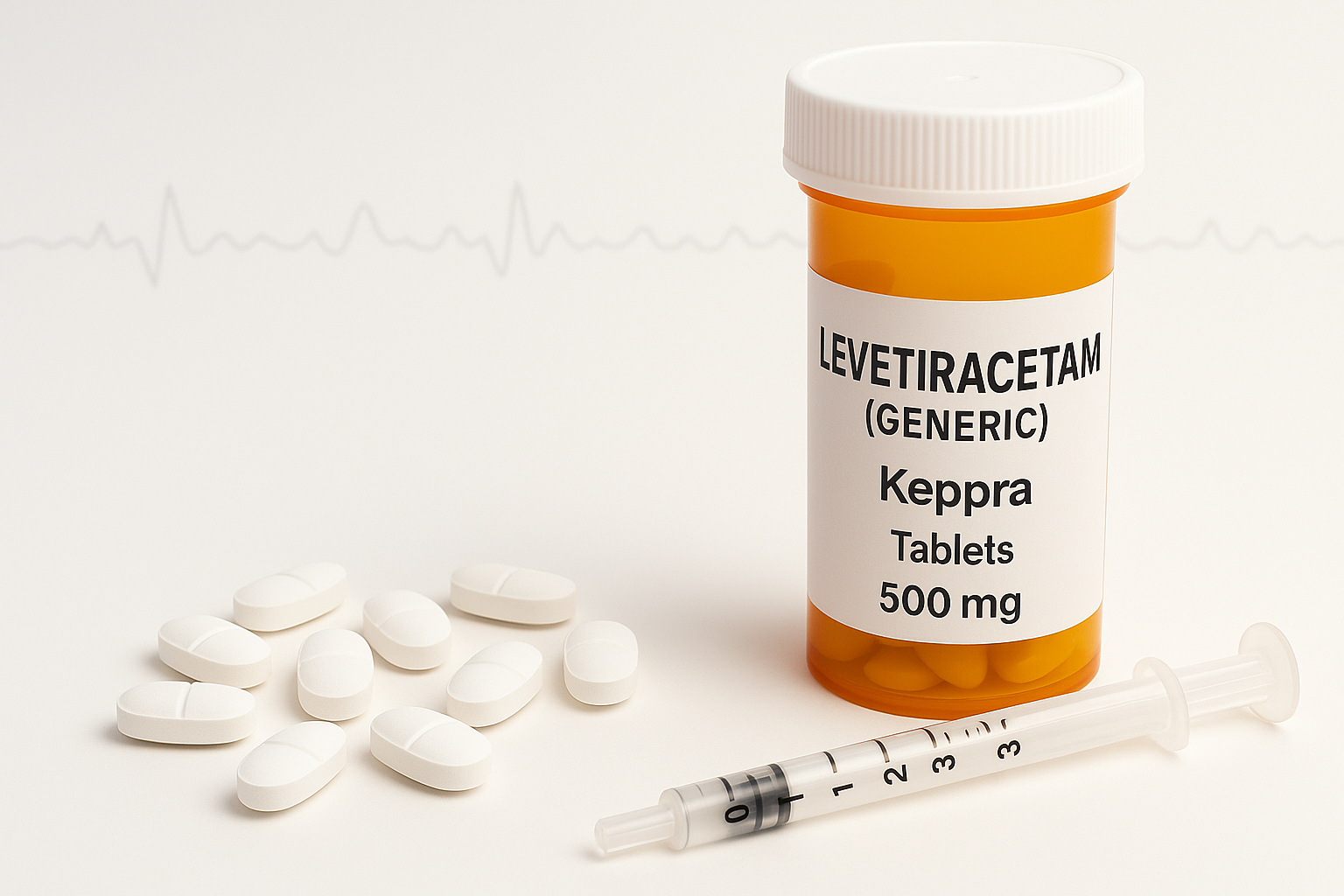Levetiracetam (Keppra): Uses, Dosage, Side Effects, Interactions & FAQs
GET HELP TODAY!
100% Confidentiality Guaranteed


Levetiracetam (Keppra) Overview at a Glance
What is it used for?
Levetiracetam helps control partial (focal) seizures, juvenile myoclonic epilepsy (JME), and primary generalized tonic-clonic seizures (PGTCS).
How do you take it?
Available as tablets, oral solution, Spritam (dissolvable tablets), and extended-release (XR). Doses are usually twice daily for IR or once daily for XR.
What’s the usual dose?
Adults often start at 500 mg twice daily (IR) or 1,000 mg once daily (XR), adjusted as needed up to 3,000 mg/day.
What are the side effects?
Common ones include drowsiness, dizziness, fatigue, and irritability. Rare but serious effects include mood changes, rash, or suicidal thoughts.
Are there key precautions?
Don’t stop suddenly; tapering is required. Watch for mood or behavior changes, avoid alcohol until you know its effects, and adjust dose for kidney problems.
Overview: What is Levetiracetam?
Levetiracetam—commonly known by the brand Keppra—is a prescription anti‑seizure (anticonvulsant) medicine used to help control several types of epilepsy seizures in adults and children. It’s widely used as add‑on therapy and, in some cases, as monotherapy for partial (focal) seizures. It is also used with other medicines for juvenile myoclonic epilepsy (JME) and primary generalized tonic‑clonic seizures (PGTCS). Levetiracetam doesn’t cure epilepsy; it helps prevent seizures while you take it.










How levetiracetam works
Levetiracetam’s exact mechanism isn’t fully defined. The best‑supported explanation is that it binds to the synaptic vesicle protein SV2A, modulating neurotransmitter release and stabilizing electrical activity in the brain. Unlike many older antiseizure drugs, it does not significantly affect sodium channels nor classic GABA receptors.
Approved indications & who can take it
Partial (focal) seizures: adults and children ≥1 month (IR formulations).
Juvenile myoclonic epilepsy (JME): adjunct therapy in patients ≥12 years.
Primary generalized tonic‑clonic seizures (PGTCS): adjunct therapy in patients ≥6 years.
Your specific indication, age, and seizure type will drive dose selection and formulation. MedlinePlus+1
Monotherapy vs add‑on: In the U.S., levetiracetam is commonly used as monotherapy for focal epilepsy in suitable patients and as add‑on therapy for JME and PGTCS. Clinicians individualize this choice based on seizure type, co‑morbidities, and prior treatment response.

Is Keppra Addictive?
Levetiracetam (Keppra) is a prescription anti-seizure medication and isn’t considered addictive. Still, taking it differently than prescribed (or stopping suddenly) can be risky—especially for seizure control. Use the quick quiz below to help guide safe next steps.
Keppra (Levetiracetam) Quiz
It may be time to talk.
Based on your answers, speaking with a treatment advisor could help you plan safe next steps. We’re here 24/7 and your conversation is confidential.
Most insurances accepted • Same-day assessments • 100% confidential
Available forms & strengths
Immediate‑release (IR) tablets: 250 mg, 500 mg, 750 mg, 1,000 mg
Oral solution: 100 mg/mL
Tablets for suspension (Spritam): age/weight‑guided dosing; dissolves quickly on the tongue or in small liquid volumes
Extended‑release (XR): 500 mg, 750 mg (brand examples: Keppra XR, Elepsia XR)
Formulation choice depends on age, swallowing ability, dosing frequency preference (BID vs once daily), and insurance coverage.
Dosing & titration (adults)
Always follow your prescriber’s instructions. The examples below are typical ranges and may be adjusted.
Immediate‑release (IR)
Starting dose: 500 mg twice daily
Titration: increase by 500 mg/day every 2 weeks based on response/tolerability
Usual max: 3,000 mg/day (divided BID)
Extended‑release (XR)Starting dose: 1,000 mg once daily
Titration: increase by 1,000 mg/day at 2‑week intervals
Usual max: 3,000 mg once daily
These schedules may vary depending on seizure type and co‑medications.
Pediatric dosing (quick guide)
Pediatric doses are based on weight (mg/kg) and age, with specific starting doses and maximums. Dosing differs for IR vs Spritam vs XR, and your pediatric neurologist will individualize the plan. Examples include starting 10 mg/kg twice daily (IR) and titrating up to ~60 mg/kg/day depending on age and seizure type. Always use exact instructions from your clinician and a metric device for liquids.
IV levetiracetam (hospital use)
When oral dosing isn’t possible, IV levetiracetam may be used with the same total daily dose as oral, administered as a 15‑minute infusion. In emergency protocols (e.g., status epilepticus), loading strategies are used per local guidelines.
Renal dose adjustment (adults)
Because levetiracetam is largely renally excreted, dose reductions are needed in impaired kidney function. Typical IRadjustments include:
CrCl 50–80 mL/min: 500–1,000 mg every 12 h
CrCl 30–50 mL/min: 250–750 mg every 12 h
CrCl <30 mL/min: 250–500 mg every 12 h
Hemodialysis: 500–1,000 mg every 24 h plus a 250–500 mg supplemental dose after dialysis
XR regimens adjust to once‑daily totals in similar bands. Your prescriber will calculate this based on labs.
How to take levetiracetam (practical tips)
Take IR twice daily (morning/evening) or XR once daily at the same time each day.
Swallow tablets whole (do not crush or chew XR).
Use the supplied oral syringe for solution; do not use a kitchen spoon.
Spritam tablets for suspension can be placed on the tongue with a sip of water or mixed into a small liquid volume per instructions.
If your refill looks different (generic/brand switch), check with your pharmacist before taking.
Missed dose: Take it when remembered unless it’s close to your next dose; don’t double up. Missing doses can trigger seizures—set reminders if needed.
More Time. More Joy. More You. Start Now.
WE ACCEPT MOST INSURANCES







Common side effects
Many people tolerate levetiracetam well, but some notice:
Drowsiness, dizziness, fatigue/weakness
Irritability or feeling unusually agitated
Headache
Loss of appetite
Stuffy nose/cold‑like symptoms
Side effects are often mild and may improve as your body adjusts. Contact your clinician if they persist or are bothersome.
Serious side effects & warnings (seek medical advice promptly)
Behavior/mood changes, depression, anxiety, suicidal thoughts/behavior
Confusion, hallucinations, or severe agitation
Severe skin reaction, rash with fever or blistering
Unusual bruising/bleeding or signs of infection (fever, sore throat)
Worsening seizures or new seizure types
Call your clinician right away for these symptoms and do not stop abruptly unless you are directed to for a severe reaction.
Interactions
Alcohol can increase drowsiness, dizziness, and impaired concentration. Many authorities advise avoiding or limiting alcohol until you know how levetiracetam affects you; alcohol and hangovers can also trigger seizures in some people.
Methotrexate
There are reports that co‑administration can reduce methotrexate clearance and raise toxicity risk, though data are mixed. If you receive high‑dose methotrexate (e.g., oncology protocols), clinicians often monitor levels closely and may adjust anti‑seizure therapy.
Other medicines
Levetiracetam has fewer CYP‑mediated interactions than many anti‑seizure drugs, but you should always share a complete medication list (including herbals like ginkgo) with your prescriber and pharmacist.
Pregnancy & breastfeeding
Pregnancy
Maintaining seizure control is critical in pregnancy. Current evidence does not show a consistent increase in major birth defects with levetiracetam; however, its blood levels can drop during pregnancy (especially late), so dose adjustments and monitoring are often needed. Discuss planning and enroll in a pregnancy registry if available.
Breastfeeding
Levetiracetam passes into breastmilk; infant serum levels are generally low, but monitor infants for excessive sleepiness and adequate weight gain. The benefits of breastfeeding are weighed against maternal treatment needs.
Never start or stop seizure medication in pregnancy without medical guidance.
Freedom Starts Here. Take Back Your Life Today.
Same-Day Admissions in Austin Available.
Storage & handling
Keep at room temperature, away from moisture and heat; do not freeze the solution. Store out of reach of children. Follow local guidance for medication disposal—do not flush unless instructed.
Can levetiracetam be stopped?
Do not stop suddenly; tapering is typically gradual over weeks to months to reduce seizure risk. Your prescriber will create a schedule suited to your history and seizure control.
Brivaracetam vs levetiracetam
Both target SV2A, but brivaracetam is more selective and may be better tolerated behaviorally for some patients; however, real‑world responses vary, and levetiracetam remains a first‑line option due to broad experience, flexible dosing, and availability. Discuss pros/cons and cost with your clinician.
Frequently Asked Questions About Levetiracetam (Keppra): Uses, Dosage, Side Effects, and Safety
What is levetiracetam used for?
Levetiracetam helps control partial (focal) seizures in adults and children, and is used with other medicines for JME and PGTCS in select age groups.
How does levetiracetam work?
It likely works by binding the SV2A protein on synaptic vesicles, calming abnormal brain activity that can lead to seizures.
What is the usual starting dose of levetiracetam?
Adults often start at 500 mg twice daily (IR) or 1,000 mg once daily (XR), then titrate based on response. Follow your prescriber’s plan.
How long does levetiracetam take to work?
Some benefit may be seen within days to weeks; full effect often emerges after dose titration over several weeks.
What are common side effects of levetiracetam?
Drowsiness, dizziness, fatigue, irritability, and headache are common. Report serious mood changes, rash, or infection signs right away.
Can I drink alcohol while taking levetiracetam?
It’s best to avoid or limit alcohol, especially at first, because it can increase drowsiness/dizziness and may trigger seizures in some people.
Is levetiracetam safe in pregnancy?
Seizure control is vital. Data don’t show a consistent rise in major birth defects, but blood levels can drop during pregnancy, so monitoring and dose changes are common. Always consult your clinician.
Can I breastfeed while taking levetiracetam?
Levetiracetam enters breastmilk; infant levels are generally low. Many can breastfeed with infant monitoring for sleepiness and growth—decisions are individualized.
What if I miss a dose?
Take it when remembered unless the next dose is near; do not double. Keeping doses regular helps prevent breakthrough seizures.
Can I stop levetiracetam once my seizures are controlled?
Don’t stop suddenly. Taper slowly under medical supervision to reduce seizure risk.
How Nova Recovery Center Supports Recovery from Levetiracetam Addiction and Abuse
At Nova Recovery Center, we understand that Levetiracetam (Keppra) misuse and dependency can create serious challenges in daily life, especially when combined with other substances or used outside of prescribed guidelines. Our team provides a safe, supportive environment where clients can address both the physical aspects of dependence and the underlying emotional or behavioral issues that often accompany it. Through individualized treatment plans, we guide each person toward healthier coping strategies and long-term recovery. Our evidence-based programs incorporate counseling, relapse prevention education, and peer support, ensuring clients are not navigating the recovery process alone. We also emphasize holistic care, addressing mental, emotional, and physical well-being to promote balance and resilience. With professional guidance, clients can safely taper from medications when appropriate and develop healthier patterns of living. For those struggling with co-occurring conditions such as depression or anxiety, our integrated approach ensures both concerns are treated simultaneously. By fostering accountability and connection, Nova Recovery Center helps clients rebuild their confidence and establish a solid foundation for sustained sobriety. If you or a loved one is facing Levetiracetam misuse, our experienced team is here to provide compassionate, comprehensive support.
Get help today. Reach out now to start your path to healing.

